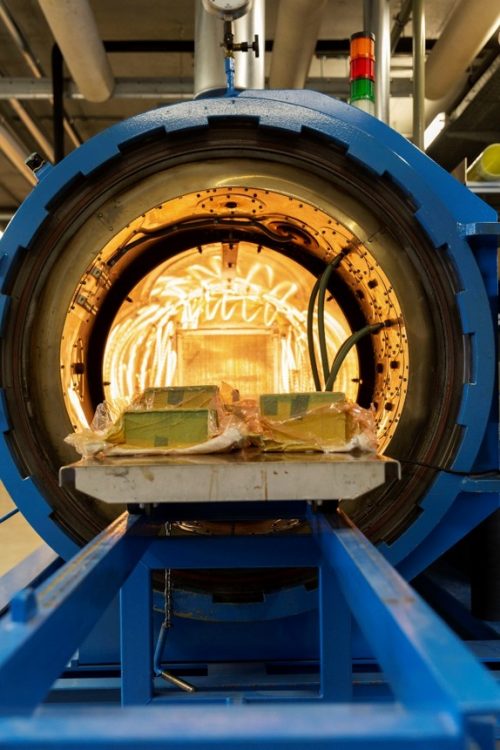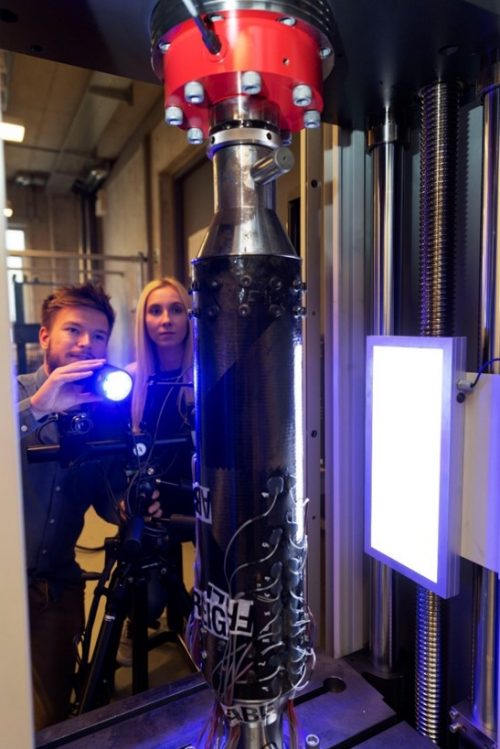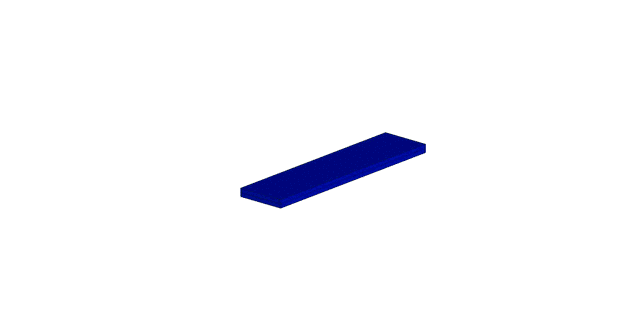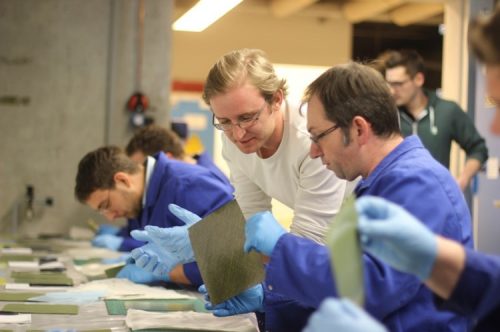2023
|
Judenmann, A.; Höfer, P.; Holtmannspötter, J.; Ehrlich, I. Additive Manufacturing of Continuous Fiber-Reinforced Composites Leichtbau Proceedings Article In: Rieser, Jasper; Endress, Felix; Horoschenkoff, Alexander; Höfer, Philipp; Dickhut, Tobias; Zimmermann, Markus (Hrsg.): Proceedings of the Munich Symposium on Lightweight Design 2022, S. 15–27, Springer International Publishing, Cham, 2023, ISBN: 978-3-031-33758-1. @inproceedings{10.1007/978-3-031-33758-1_2,
title = {Additive Manufacturing of Continuous Fiber-Reinforced Composites},
author = {A. Judenmann and P. Höfer and J. Holtmannspötter and I. Ehrlich},
editor = {Jasper Rieser and Felix Endress and Alexander Horoschenkoff and Philipp Höfer and Tobias Dickhut and Markus Zimmermann},
url = {https://link.springer.com/chapter/10.1007/978-3-031-33758-1_2},
doi = {10.1007/978-3-031-33758-1_2},
isbn = {978-3-031-33758-1},
year = {2023},
date = {2023-01-01},
urldate = {2023-01-01},
booktitle = {Proceedings of the Munich Symposium on Lightweight Design 2022},
pages = {15–27},
publisher = {Springer International Publishing},
address = {Cham},
abstract = {The mechanical properties of additively manufactured plastic components, i. e. strength and stiffness, can limit their use as load-bearing structures. In particular, the use of continuous reinforcing fibers can significantly improve the mechanical properties of additively manufactured components and enable the production of load-bearing fiber composite structures. In this context, it seems reasonable to develop the required equipment and process workflows, but also procedures for the load-optimized positioning of fiber paths inside the component and its design. In this paper, the current challenges in the field of technology development of continuous-fiber reinforced 3D printing are highlighted. Possible solutions for the development of a 3D printing system and the generation of necessary toolpaths are presented on the basis of the FIBER-PRINT 3 project. Contents from a subsequent project present a design strategy for a load-optimized positioning of the continuous fiber reinforcement within the component and the implemented calculation of principal stress trajectories as a step towards optimization of the fiber positioning.},
keywords = {},
pubstate = {published},
tppubtype = {inproceedings}
}
The mechanical properties of additively manufactured plastic components, i. e. strength and stiffness, can limit their use as load-bearing structures. In particular, the use of continuous reinforcing fibers can significantly improve the mechanical properties of additively manufactured components and enable the production of load-bearing fiber composite structures. In this context, it seems reasonable to develop the required equipment and process workflows, but also procedures for the load-optimized positioning of fiber paths inside the component and its design. In this paper, the current challenges in the field of technology development of continuous-fiber reinforced 3D printing are highlighted. Possible solutions for the development of a 3D printing system and the generation of necessary toolpaths are presented on the basis of the FIBER-PRINT 3 project. Contents from a subsequent project present a design strategy for a load-optimized positioning of the continuous fiber reinforcement within the component and the implemented calculation of principal stress trajectories as a step towards optimization of the fiber positioning. |
2022
|
Schlamp, M. Der Einfluss elliptischer Krümmung auf das Verformungs- und Schädigungsverhalten glasfaserverstärkter Kunststoffstrukturen Leichtbau Promotionsarbeit 2022. @phdthesis{Schlamp2022,
title = {Der Einfluss elliptischer Krümmung auf das Verformungs- und Schädigungsverhalten glasfaserverstärkter Kunststoffstrukturen},
author = {M. Schlamp},
editor = {Albert-Ludwigs-Universität Freiburg},
url = {urn:nbn:de:bsz:25-freidok-2280647},
doi = {10.6094/UNIFR/228064},
year = {2022},
date = {2022-05-24},
howpublished = {Online},
keywords = {},
pubstate = {published},
tppubtype = {phdthesis}
}
|
2021
|
Schimmer, F.; Gebhardt, J.; Motsch-Eichmann, N.; Hausmann, J.; Ehrlich, I. The effect of curvature on the low-velocity impact resistance of CF/PEEK laminates Leichtbau Proceedings Article In: 30 Years IVW Anniversary Colloquium, Leibnitz-Institut für Verbundwerkstoffe Kaiserslautern, 2021. @inproceedings{Schimmer2021,
title = {The effect of curvature on the low-velocity impact resistance of CF/PEEK laminates},
author = {F. Schimmer and J. Gebhardt and N. Motsch-Eichmann and J. Hausmann and I. Ehrlich},
year = {2021},
date = {2021-09-09},
booktitle = {30 Years IVW Anniversary Colloquium},
address = {Kaiserslautern},
organization = {Leibnitz-Institut für Verbundwerkstoffe},
keywords = {},
pubstate = {published},
tppubtype = {inproceedings}
}
|
2020
|
Kastenmeier, A. Biegeverhalten faserverstärkter Kunststoffrohre unter Berücksichtigung einer mehrreihigen Bolzenverbindung Leichtbau Promotionsarbeit Universität der Bundeswehr München, Ostbayerische Technische Hochschule Regensburg, urn:nbn:de:bvb:706-7105, 2020. @phdthesis{Kastenmeier2020,
title = {Biegeverhalten faserverstärkter Kunststoffrohre unter Berücksichtigung einer mehrreihigen Bolzenverbindung},
author = {A. Kastenmeier},
editor = {Ehrlich, Ingo, Prof. Dr.-Ing.; Brünig, Michael, Univ.-Prof. Dr.-Ing. habil.; Gebbeken, Norbert, Univ.-Prof. Dr.-Ing. habil. },
url = {https://athene-forschung.unibw.de/135000
},
year = {2020},
date = {2020-12-10},
address = {Werner-Heisenberg-Weg 39, 85577 Neubiberg},
school = {Universität der Bundeswehr München, Ostbayerische Technische Hochschule Regensburg, urn:nbn:de:bvb:706-7105},
abstract = {In der vorliegenden Arbeit wird die Charakterisierung des mechanischen Verhaltens von auskragenden Rohren aus kohlenstofffaserverstärktem Kunststoff (CFK) mit Querkraftbelastung an einem Ende und einer mehrreihigen Bolzenverbindung am anderen Ende behandelt. Bolzenverbindungen mit Fügepartner aus CFK werden im Stand der Technik nur an ebenen, zug- oder druckbelasteten, Verbindungen untersucht, weshalb der Einfluss der Biegebelastung, der gekrümmten Auflageflächen und des geschlossenen Rohrprofils untersucht und qualifiziert wird. Zudem zeigt sich ein Effekt der Abstützung bzw. resultierenden Verformungsbehinderung. Die Grundlage der Untersuchungen bilden 2-Punkt-Biegeversuche mit Verzerrungs- und Verschiebungsmessungen, die über FE-Modelle numerisch abgebildet und in einer Verzerrungs- und Spannungsanalyse detaillierter ausgewertet werden. Zur Darstellung des Einflusses der Biegebelastung werden zudem reine Zug- und Drucklasten aufgebracht, ausgewertet und abgeglichen. In drei Variationen des Biegeversuchs werden zudem, sowohl experimentell als auch numerisch, Effekte zu einer möglichen Steigerung der Verbindungsfestigkeit untersucht. Dazu zählt die Verwendung von zusätzlichen Schichten aus Titanlegierung im Kraftüberleitungsbereich, ein Versetzen der Bolzen im Umfang und eine Änderung der Abstützung in Lastrichtung. Für das Biegeverhalten der CFK-Rohre im frei auskragenden Bereich werden kontinuumsmechanische Modelle der anisotropen Elastizität für Rohre unter reiner Biegebelastung beschrieben, adaptiert und bezüglich der Ergebnisse bewertet. Um die Vergleichbarkeit der Berechnungsmodelle und Versuche zu gewährleisten, wird einerseits der Einfluss der speziellen Schichtstruktur in gewickelten CFK-Rohren diskutiert und andererseits werden die transversal-isotropen Materialeigenschaften der Einzelschicht an Probekörpern aus den Rohren bestimmt. },
type = {Dissertation},
keywords = {},
pubstate = {published},
tppubtype = {phdthesis}
}
In der vorliegenden Arbeit wird die Charakterisierung des mechanischen Verhaltens von auskragenden Rohren aus kohlenstofffaserverstärktem Kunststoff (CFK) mit Querkraftbelastung an einem Ende und einer mehrreihigen Bolzenverbindung am anderen Ende behandelt. Bolzenverbindungen mit Fügepartner aus CFK werden im Stand der Technik nur an ebenen, zug- oder druckbelasteten, Verbindungen untersucht, weshalb der Einfluss der Biegebelastung, der gekrümmten Auflageflächen und des geschlossenen Rohrprofils untersucht und qualifiziert wird. Zudem zeigt sich ein Effekt der Abstützung bzw. resultierenden Verformungsbehinderung. Die Grundlage der Untersuchungen bilden 2-Punkt-Biegeversuche mit Verzerrungs- und Verschiebungsmessungen, die über FE-Modelle numerisch abgebildet und in einer Verzerrungs- und Spannungsanalyse detaillierter ausgewertet werden. Zur Darstellung des Einflusses der Biegebelastung werden zudem reine Zug- und Drucklasten aufgebracht, ausgewertet und abgeglichen. In drei Variationen des Biegeversuchs werden zudem, sowohl experimentell als auch numerisch, Effekte zu einer möglichen Steigerung der Verbindungsfestigkeit untersucht. Dazu zählt die Verwendung von zusätzlichen Schichten aus Titanlegierung im Kraftüberleitungsbereich, ein Versetzen der Bolzen im Umfang und eine Änderung der Abstützung in Lastrichtung. Für das Biegeverhalten der CFK-Rohre im frei auskragenden Bereich werden kontinuumsmechanische Modelle der anisotropen Elastizität für Rohre unter reiner Biegebelastung beschrieben, adaptiert und bezüglich der Ergebnisse bewertet. Um die Vergleichbarkeit der Berechnungsmodelle und Versuche zu gewährleisten, wird einerseits der Einfluss der speziellen Schichtstruktur in gewickelten CFK-Rohren diskutiert und andererseits werden die transversal-isotropen Materialeigenschaften der Einzelschicht an Probekörpern aus den Rohren bestimmt. |
Lindner, M.; Berndt, D.; Tschurtschenthal, K.; Ehrlich, I.; Jungbauer, B.; Schreiner, R.; Pipa, A. V.; Hink, R.; Brandenburg, R.; Neuwirth, D.; Karpen, N.; Bonaccurso, E.; Weichwald, R.; Max, A.; Caspari, R. Aircraft Icing Mitigation by DBD-based Micro Plasma Actuators Leichtbau Proceedings Article In: AIAA AVIATION 2020 FORUM, 2020. @inproceedings{Lindner2020,
title = {Aircraft Icing Mitigation by DBD-based Micro Plasma Actuators},
author = {M. Lindner and D. Berndt and K. Tschurtschenthal and I. Ehrlich and B. Jungbauer and R. Schreiner and A. V. Pipa and R. Hink and R. Brandenburg and D. Neuwirth and N. Karpen and E. Bonaccurso and R. Weichwald and A. Max and R. Caspari},
url = {https://arc.aiaa.org/doi/10.2514/6.2020-3243},
doi = {10.2514/6.2020-3243},
year = {2020},
date = {2020-06-08},
publisher = {AIAA AVIATION 2020 FORUM},
abstract = {We present the application of plasma actuators as a technology for ice prevention at airfoils. The miniaturized dielectric barrier discharge (DBD) plasma actuators (PA) were fabricated by means of microelectromechanical systems (MEMS). We elucidate how to make the actuator samples scalable and applicable to any desired shape by the use of flexible inorganic zirconia substrates. For this purpose, we applied our developed embedding method to integrate the micro actuators in modern carbon/glass fiber reinforced polymer (CFRP/GFRP) materials. Next, the embedded actuator samples were mounted on a mechanical air profile-like fixture and placed in the icing wind tunnel iCORE. The samples were tested in rime ice conditions at temperatures of -15 to -20° C and air speeds up to 30 m/s. Unlike other groups we used a thin film zirconia substrate as dielectric for the plasma actuator. Due to the low substrate thickness of just 150 µm, an operating voltage of 2 kVRMS is already sufficient enough for a stable plasma formation. The experiments show that the operated actuator was able to prevent the ice formation and first indications of a De-icing function were also found. Hence, we show that it is feasible to realize an anti-icing system with zirconia-based plasma actuators operated at lower voltages compared to conventional ones.},
keywords = {},
pubstate = {published},
tppubtype = {inproceedings}
}
We present the application of plasma actuators as a technology for ice prevention at airfoils. The miniaturized dielectric barrier discharge (DBD) plasma actuators (PA) were fabricated by means of microelectromechanical systems (MEMS). We elucidate how to make the actuator samples scalable and applicable to any desired shape by the use of flexible inorganic zirconia substrates. For this purpose, we applied our developed embedding method to integrate the micro actuators in modern carbon/glass fiber reinforced polymer (CFRP/GFRP) materials. Next, the embedded actuator samples were mounted on a mechanical air profile-like fixture and placed in the icing wind tunnel iCORE. The samples were tested in rime ice conditions at temperatures of -15 to -20° C and air speeds up to 30 m/s. Unlike other groups we used a thin film zirconia substrate as dielectric for the plasma actuator. Due to the low substrate thickness of just 150 µm, an operating voltage of 2 kVRMS is already sufficient enough for a stable plasma formation. The experiments show that the operated actuator was able to prevent the ice formation and first indications of a De-icing function were also found. Hence, we show that it is feasible to realize an anti-icing system with zirconia-based plasma actuators operated at lower voltages compared to conventional ones. |



















